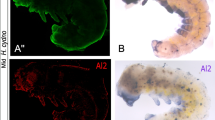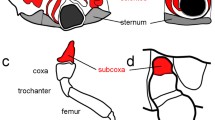Abstract
The appendages of an insect are subdivided into distinct segments or podomeres. Many genes responsible for the regionalization of the growing limb into subdomains have been isolated from Drosophila. So far, only one gene is known in the leg that is solely required for specifying the distal-most pattern element—the pretarsal claw. In Drosophila, the gene aristaless is expressed in the centre of the antennal and leg imaginal disc that represents the most distal position of appendages, and in a proximal region. When Drosophila aristaless function is impaired, antennae and legs develop without their distal-most structures—the arista and the claw. We describe here the analysis of aristaless in the beetle Tribolium—an insect that shows a different, more ancestral mode of appendage formation than Drosophila. In Tribolium, appendages grow out continuously during embryogenesis, and no imaginal discs are formed. Tribolium aristaless (Tc-al) expression starts midway during appendage elongation, and is seen in a distal and a proximal position of head and trunk appendages. At the end of embryogenesis, Tc-al is seen in four expression domains in the leg, in the dorsal epidermis, and ventrally in every segment in lateral groups of cells, presumably the histoblasts. Like in the Drosophila adult, Tc-al is required in the larva for the formation of the most distal structures of the leg and the antenna as revealed by RNAi experiments. We conclude that aristaless is evolutionarily robust, meaning that it has retained its expressional and functional characteristics, although a heterochronic change of the process of appendage elongation took place towards the evolution of the highly derived diptera.



Similar content being viewed by others
References
Abu-Shaar M, Mann RS (1998) Generation of multiple antagonistic domains along the proximodistal axis during Drosophila leg development. Development 125:3821–3830
Beermann A, Jay DG, Beeman RW, Hülskamp M, Tautz D, Jürgens G (2001) The Short antennae gene of Tribolium is required for limb development and encodes the orthologue of the Drosophila Distal-less protein. Development 128:287–297
Beermann A, Aranda M, Schröder R (2004) The Sp8 zinc-finger transcription factor is involved in allometric growth of the limbs in the beetle Tribolium castaneum. Development 131:733–742
Beverdam A, Brouwer A, Reijnen M, Korving J, Meijlink F (2001) Severe nasal clefting and abnormal embryonic apoptosis in Alx3/Alx4 double mutant mice. Development 128:3975–3986
Bienvenu T, Poirier K, Friocourt G, Bahi N, Beaumont D, Fauchereau F, Ben Jeema L, Zemni R, Vinet MC, Francis F, Couvert P, Gomot M, Moraine C, van Bokhoven H, Kalscheuer V, Frints S, Gecz J, Ohzaki K, Chaabouni H, Fryns JP, Desportes V, Beldjord C, Chelly J (2002) ARX, a novel Prd-class-homeobox gene highly expressed in the telencephalon, is mutated in X-linked mental retardation. Hum Mol Genet 11:981–991
Bucher G, Scholten J, Klingler M (2002) Parental RNAi in Tribolium (Coleoptera). Curr Biol 12:R85–R86
Campbell G (2002) Distalization of the Drosophila leg by graded EGF-receptor activity. Nature 418:781–785
Campbell G, Tomlinson A (1998) The roles of the homeobox genes aristaless and Distal-less in patterning the legs and wings of Drosophila. Development 125:4483–4493
Campbell G, Weaver T, Tomlinson A (1993) Axis specification in the developing Drosophila appendage: the role of wingless, decapentaplegic, and the homeobox gene aristaless. Cell 74:1113–1123
Johnston LA, Schubiger G (1996) Ectopic expression of wingless in imaginal discs interferes with decapentaplegic expression and alters cell determination. Development 122:3519–3529
Klingler M, Gergen JP (1993) Regulation of runt transcription by Drosophila segmentation genes. Mech Dev 43:3–19
Lecuit T, Cohen SM (1997) Proximal-distal axis formation in the Drosophila leg. Nature 388:139–145
Miyawaki K, Inoue Y, Mito T, Fujimoto T, Matsushima K, Shinmyo Y, Ohuchi H, Noji S (2002) Expression patterns of aristaless in developing appendages of Gryllus. Mech Dev 113:181–184
Qu S, Tucker SC, Ehrlich JS, Levorse JM, Flaherty LA, Wisdom R, Vogt TF (1998) Mutations in mouse Aristaless-like4 cause Strong’s luxoid polydactyly. Development 125:2711–2721
Rauskolb C (2001) The establishment of segmentation in the Drosophila leg. Development 128:4511–4521
Schneitz K, Spielmann P, Noll M (1993) Molecular genetics of aristaless, a prd-type homeo box gene involved in the morphogenesis of proximal and distal pattern elements in a subset of appendages in Drosophila. Genes Dev 7:4743–4752
Schröder R (2003) The genes orthodenticle and hunchback substitute for bicoid in the beetle Tribolium. Nature 422:621–625
Tautz D, Pfeifle C (1989) A non-radioactive in situ hybridization method for the localization of specific RNAs in Drosophila embryos reveals translational control of the segmentation gene hunchback. Chromosoma 98:81–85
Tsuji T, Sato A, Hiratani I, Taira M, Saigo K, Kojima T (2000) Requirements of Lim1, a Drosophila LIM-homeobox gene, for normal leg and antennal development. Development 127:4315–4323
Acknowledgements
We thank S. Brown, R. Beeman, and O. Betz for discussions, R. Reuter for constant support, and T. Mader for excellent technical assistance. This work was funded in part by the DFG.
Author information
Authors and Affiliations
Corresponding author
Additional information
Edited by D. Tautz
Rights and permissions
About this article
Cite this article
Beermann, A., Schröder, R. Functional stability of the aristaless gene in appendage tip formation during evolution. Dev Genes Evol 214, 303–308 (2004). https://doi.org/10.1007/s00427-004-0411-7
Received:
Accepted:
Published:
Issue Date:
DOI: https://doi.org/10.1007/s00427-004-0411-7




